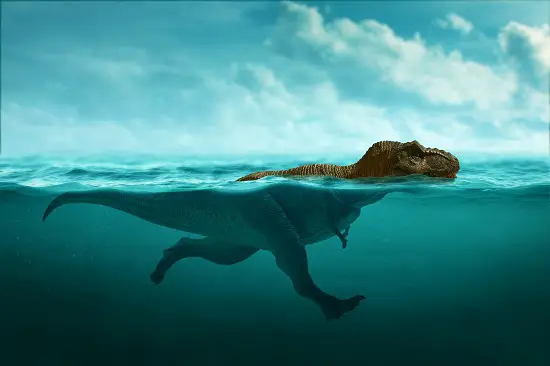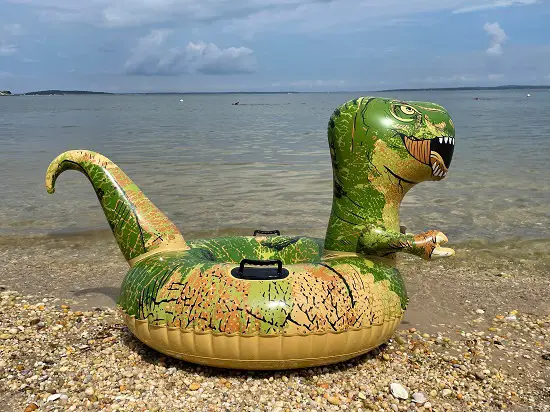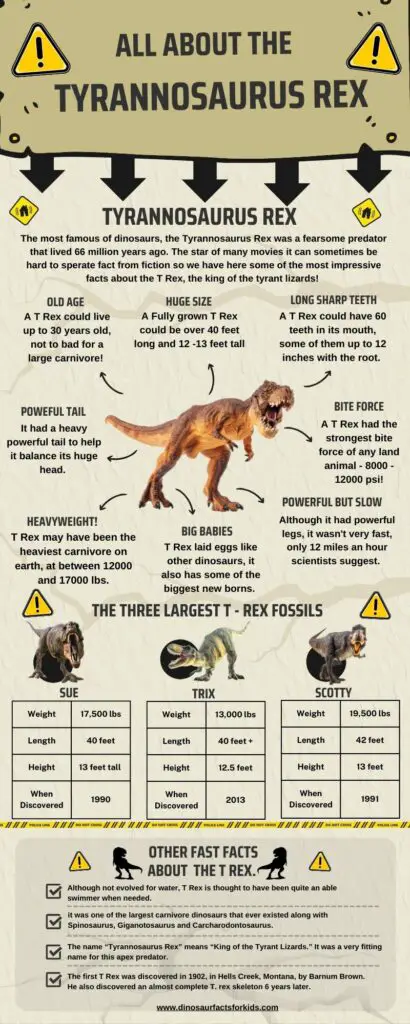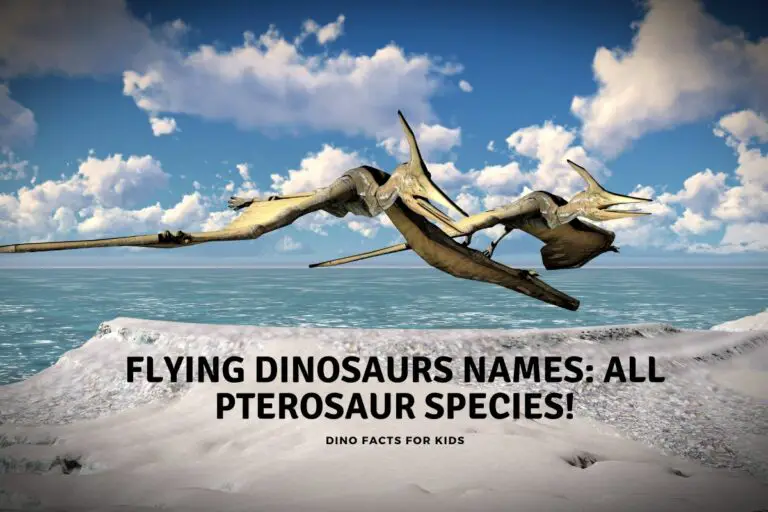Could T-Rex Swim?
As its name tells us quite clearly, the Tyrannosaurus rex, or just T-rex for short, is the king of the apex predators in the dinosaur world. Of course, the story gets a bit more complicated than all that when you think about different predators living in different historical eras.
Research from 2013 demonstrated that Tyrannosaurs Rex was likely a capable though not adept swimmer. Its relatively light bones, powerful legs and tail could propel it through, if not under, water. However, it is not thought it was suited to hunting in a fully aquatic environment like Spinosaurus.
However, the somewhat filmic media dominated nature of most people’s understanding of dinosaurs leads us to agree that T-rex was indeed top of the food chain.
We know that they were incredibly strong, excellent hunters, and of course physically very large, but how did they fare in the water? This is what today’s blog will focus on – could T-rex swim?

Was T-Rex a Swimmer?
The surprising answer to this question for many people is, in fact, yes! The T-rex, despite its apparent physical shortcomings — particularly in the arms department — was a beast that could handle itself with some degree of competency in the water. It wasn’t the aquatic beast that Spinosaurus was, and a few other swimming dinosaurs were, but it could certainly enter the water and navigate its way when required.
In fact recent dinosaur documentaries, Prehistoric Planet have gone further to depict how and why this 40 feet and 10 ton dinosaur may have been able to swim. (see Youtube link below)
It suggested, based on the research into tracks found on river beds, ( more on this research by scott person below) that it would be able to use its powerful hind legs to swim large distances.
So despite the birdlike hind limbs designed to run and walk these legs would be strong enough in water. These tracks (swim traces) have been found on fossilized river beds suggesting T Rex was if not at home, was at least comfortable swimming in water.
How Do We Know That T-Rex Could Swim?
The best evidence discovered to date came from China’s Sichuan province, where Scott Persons and his team from the University of Alberta were researching in 2013. While working there, Persons and his team discovered interesting track marks in a prehistoric riverbed, on which the presence of certain cracks and ripple marks indicate that it flowed during some periods, and was dried up at other times.
The track marks, spaced about 50-feet apart, indicate a T-rex using its claws to scrape the river bed to help propel it along the waterway. Persons has thus theorized that T-rex could indeed use its powerful legs to paddle great distances in water, with a swimming style that is actually quite similar to that of an alligator navigating a river or similar waterway.
Persons himself believed that the main reason for T-rex to enter the water and swim was for hunting down prey. The general anatomy of the T-rex, especially the many air sacs that it had within its body and its bones, make it plausible that a T-rex could have handled itself within the water to a surprisingly high degree.
What’s more, it also makes sense for the T-rex to head into water when chasing prey because it would be a good opportunity to catch prey off guard, with many aquatic or semi-aquatic creatures perceiving the water as a safe haven from a large predator such as the T-rex.
Comparing T Rex’s swimming ability to its modern day relatives.
although comparable in size to elephants in today’s animal kingdom the closest, looking and structurally at least, animals alive today to a T Rex are the large flightless birds like emus, cassowaries and ostriches.
It may be surprising that these large birds and modern relatives of T Rex, similar in movement to a T Rex are actually very skilled swimmers, capable of swimming miles to new feeding grounds,
Ostriches and other large flightless birds may not frequently swim, but they have the ability to do so, and they are without the large powerful tail that a t Rex posses which may suggest while they are actually good swimmers, the larger but similar body shaped t Rex was better in the water than their modern relatives.
How Well Could T-Rex Swim?
So, there’s decent evidence to suggest that T-rex could indeed swim, but how well exactly? The fact is that T-rex was no Spinosaurus. T-rex was still a land-dwelling predator, and even though it often occupied swampy areas, it wasn’t a natural swimmer nor is there any indication of T-rex actively seeking water as any part of its habitat.
Persons’ evidence, however, does clearly show an aquatic capability, using its claws for propulsion and tail or balance and direction. The true sign of a great swimming ability in animals, however, is marked by their ability to go under the water to either search for or chase their prey. In this sense, we now see the limitations of T-rex’s swimming capabilities.
T-rex did not have any of the apparent features that one might expect when looking at a predator that could also swim underwater. Neither its lungs, nor other physical features point to this, unlike with Spinosaurus which featured apparent underwater swimming abilities that helped it to be a genuinely aquatic dinosaur. Therefore, prey that sought to escape T-rex in the water need only dive below the surface or be more suited to life in an aquatic environment.
This was perhaps of no concern to a T-rex, however, as Persons’ speculates that the chief reason for entering any body of water in the first place would be to chase down prey. It’s quite possible that prey would slow down upon entering the water, thinking that the T-rex had no way to follow. This would allow the T-rex key moments to close the gap and go in for the kill, possibly while paddling a river or lake.
These notions have also led researchers to believe that this is the reason T-rex had little trouble hunting sauropods, which were herbivorous dinosaurs that could often be found close to bodies of water. There is evidence to suggest that those T-rex dinosaurs that lived in what is now North America, gradually migrated southward while sauropods were migrating northward from what is now Mexico. The resulting crossover could explain how T-rex came to hunt sauropods.

We also take a look at if Stegosaurus could swim and if triceratops could swim here on the site as well.
T Rex teeth Were Suited to Land Based Prey.
However, it’s clear to most that T-rex certainly lacked the agility and build to be an underwater predator, even in short bursts. Further evidence of T-rex’s lack of underwater credentials are found in its teeth. T-rex is known for its long, sharp, pick-ax-like teeth. These are ideal for attacking other land-based prey, or even something swimming on the surface of a river or lake. However, when it comes to underwater hunting, it’s a different story.
When you think of underwater predators in the modern day, it’s likely that the first creature that comes to mind is the shark, right? When you picture a shark’s teeth, how do they look? Are they long and ax-like? No. In fact, sharks’ teeth are short, wide and sharp like the top of a spear or arrow head.
This is critically important when an underwater predator wants to grip its prey while hunting. If you’ve tried to hold onto a wet fish while fishing, you know how slippery they can be. Imagine what they’re like underwater. A T-rex’s teeth would not be as useful in that scenario.
When you take a look at a Spinosaurus Vs. A T Rex teeth you can also see how evolution developed them for very different tasks. The pointed long teeth of Spinosaurus, Which you can buy much more cheaply than a T Rex tooth by the way! , although shorter, are much more suited to grabbing and piercing fish quickly. they are very like a crocodile or alligators teeth. T Rexes are much more useful at inflicting wounds and tearing flesh which is more suited to a land based carnivorous diet.
So while Tyrannosaurus was likely to be a strong swimmer, it did live in a wet part of the world at the time! it would not have been particularly good at catching fish to eat. They also had shorter arms than a Spinosaurus and would have not been able to use them to grasp or hold fish.
What are some water Dinosaurs?
We have an article or two on the site that goes into more details on the likely candidates for water based or swimming dinosaurs which are linked below but the current suggestions for water dinosaurs are the Spinosaurus as we mentioned above, and you can read more about that here, and the dinosaurs listed below.
- Suchomimus
- Halszkaraptor
- Baryonyx
- Irritator
- The biggest Water Dinosaurs
- Swimming Dinosaurs Fact or Fiction
- Could Pyroraptor Swim
- How Big was a T Rex Brain
So currently there are thought to be two truly, or at least mostly, aquatic dinosaurs the spinosaurus and the Halszkaraptor. although other Spinosaurs and water bird like dinosaurs are likely waiting to be discovered. You can read more about these in the links above.
We have a huge selection or articles to answer the common and some less common questions about the Tyrannosaurus Rex here on the site and to make it easier to access we have them in the table below.
Conclusion
T Rex is now thought to have been a strong swimmer when the occasion arose, and capable of swimming some distance. However it was not a water or swimming dinosaur like Spinosaurus or Halszkaraptor.
It back legs and tail were powerful and would have enabled it to swim well, coupled with hollow or air filled bones but its jaws and teeth suggest it did not catch and eat fish or other aquatic prey like some other dinosaurs and its swimming would be reserved for moving from place to place rather than any hunting activities.
You can check out what we think of other dinosaurs swimming abilities here on the site with the links below.
- Could Stegosaurus Swim
- Could Tyrannosaurus Swim
- Could Triceratops Swim
- Could Pyroraptor Swim
- Could Velociraptor Swim
References
- https://www.rcinet.ca/en/2013/04/09/university-of-alberta-researcher-helps-discover-that-two-legged-dinosaurs-could-swim/
- https://www.dailymail.co.uk/sciencetech/article-2306230/Researchers-reveal-dino-paddle-T-Rex-used-wade-rivers.html
- https://www.eurekalert.org/news-releases/909019
- https://www.waterworksswim.com/swim-library/detail/2014-11-06-tyrannosaurus-rex-was-aquatic-post-423
- https://www.youtube.com/watch?v=7mtaXP2Nar0
- https://www.audubon.org/news/new-aquatic-dinosaur-find-strange-and-startling-avian-hodgepodge
- https://www.latimes.com/science/sciencenow/la-sci-sn-duck-like-dinosaur-20171206-htmlstory.html
Hi, I am Roy Ford a General Studies and English Teacher who has taught all over the world. What started as a fossil collection became a great way to teach, motivate and inspire students of all ages and all over the world about dinosaurs and from that and children’s love of dinosaurs came the site dinosaur facts for kids, a resource for all ages.










